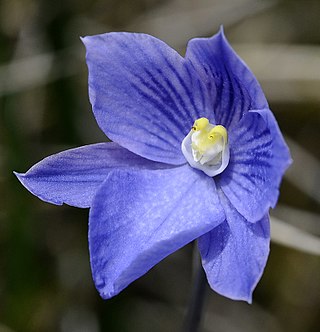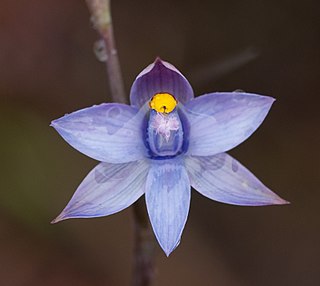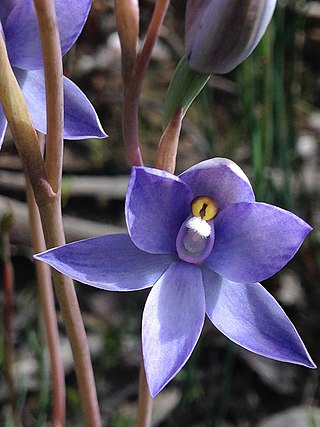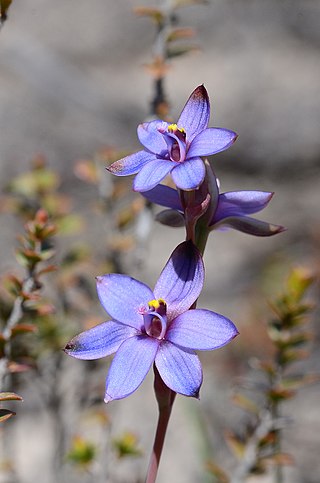
Thelymitra cyanea, commonly known as the veined sun orchid in Australia and as the swamp sun orchid or striped sun orchid in New Zealand, is a species of orchid which is native to New Zealand and south-eastern Australia. It has a single erect, fleshy, channelled leaf and up to five bright blue flowers with darker blue veins. It is usually found growing in swamps, sphagnum bogs, and subalpine herbfields, often in clonal colonies.

Thelymitra malvina, commonly called the mauve-tufted sun orchid, is a species of orchid that is native to eastern Australia and New Zealand. It has a single large, fleshy leaf and up to twenty five blue to mauve flowers with pink or mauve tufts on top of the anther.

Thelymitra megacalyptra, commonly called the plains sun orchid, is a species of orchid that is endemic to eastern Australia. It has a single erect, fleshy leaf and up to fifteen blue to purplish, sometimes lilac, pink or white flowers with white tufts on top of the anther. It is known as Thelymitra megcalyptra by some authorities.
Thelymitra cyanapicata, commonly called the dark-tipped sun orchid, is a species of orchid that is endemic to South Australia. It has a single fleshy, linear, channelled leaf and up to three small blue or pale purplish to maroon flowers with a dark purplish blue top of the anther.

Thelymitra granitora, commonly called the coastal granite sun orchid or coastal sun orchid, is a species of orchid in the family Orchidaceae and is endemic to the south-west of Western Australia. It has a single short, curved and channelled dark green leaf and up to eight relatively large pale blue or white, self-pollinating flowers with white mop-like tufts on the top of the anther.

Thelymitra holmesii, commonly called the blue star sun orchid, is a species of orchid that is endemic to south-eastern Australia. It has a single long, narrow, fleshy leaf and up to nine purplish blue to mauve flowers with a deeply notched lobe on top of the anther.

Thelymitra peniculata, commonly called the trim sun orchid, is a species of orchid that is endemic to southern eastern Australia. It has a single long, erect, fleshy, channelled leaf and up to eighteen deep blue to purple self-pollinating flowers.
Thelymitra planicola, commonly called the glaucous sun orchid, is a species of orchid that is endemic to southern eastern Australia. It has a single erect, leathery, channelled, dark green leaf and up to twelve blue flowers with darker veins. The plant has a bluish green hue and the flowers are self-pollinating, only opening widely on hot days.
Thelymitra lucida, commonly called the glistening sun orchid, is a species of orchid that is endemic to south eastern Australia. It has a single erect, fleshy leaf and up to seven dark blue flowers with the sepals a lighter blue than the petals.

Thelymitra mucida, commonly called the plum sun orchid or plum orchid, is a species of orchid that is endemic to southern Australia. It has a single erect, fleshy, linear leaf and up to six blue, purplish or plum coloured flowers with a thick, sticky secretion on the anther lobe.

Thelymitra adorata, commonly called the Wyong sun orchid or praying sun orchid, is a species of orchid that is endemic to a very small area of New South Wales. It has a single relatively large, erect, fleshy, channelled leaf and up to thirteen deep blue, self-pollinating flowers.

Thelymitra epipactoides, commonly called the metallic sun orchid, is a species of orchid that is endemic to south-eastern continental Australia. It has a single relatively large, leathery leaf and up to twenty large flowers that range in colour from pink to reddish but have a distinctive arrangement of lobes above the anther.

Thelymitra azurea, commonly called the azure sun orchid, is a species of orchid that is endemic to south-eastern Australia. It has a single fleshy, grass-like leaf and up to ten dark azure blue flowers with darker veins. The lobe on top of the anther has a toothed or warty tip.

Thelymitra canaliculata, commonly called the flushed sun orchid or blue sun orchid is a species of orchid in the family Orchidaceae and is endemic to the south-west of Western Australia. It has a single erect, fleshy leaf and up to twenty eight blue flowers with darker veins and sometimes flushed with pink. The lobe on top of the anther is blackish with a yellow crest.
Thelymitra jonesii, commonly called the skyblue sun orchid, is a species of orchid that is endemic to Tasmania. It has a single erect, fleshy, linear, dark green leaf and up to six relatively small light blue to azure blue flowers with darker veins. It is a rare orchid known from only four scattered locations in moist coastal heath.
Thelymitra latiloba, commonly called the wandoo sun orchid or wandoo shirt orchid, is a species of orchid in the family Orchidaceae and endemic to the south-west of Western Australia. It has a single erect, fleshy, channelled, dark green leaf and up to twelve blue flowers with darker blue veins and sometimes flushed with mauve. The lobe on top of the anther is wavy.
Thelymitra occidentalis, commonly called the western azure sun orchid or rimmed orchid, is a species of orchid in the family Orchidaceae and is endemic to the south-west of Australia. It has a single erect, fleshy, channelled, dark green leaf and up to fifteen blue flowers with darker blue veins and sometimes flushed with pink. The lobe on top of the anther has a wavy, yellow crest.
Thelymitra alpicola, commonly called the alpine striped sun orchid, is a species of orchid that is endemic to eastern Australia. It has a single erect, dark green grass-like leaf and up to six relatively large, deep purplish blue flowers with darker streaks. It grows in subalpine to montane habitats.
Thelymitra incurva, commonly called the coastal striped sun orchid, is a species of orchid that is endemic to south-eastern Australia. It has a single erect, dark green grass-like leaf and up to seven relatively large, pale blue flowers lacking the darker veins of some other thelymitras, especially the otherwise similar striped sun orchid. It grows in coastal areas of far south-eastern New South Wales and north-eastern Victoria.
Thelymitra atronitida, commonly called the black-hooded orchid, is a species of orchid that is endemic to south-eastern Australia. It has a single erect, leathery, leaf and up to eight moderately dark blue, self-pollinating flowers that only open on hot days.











